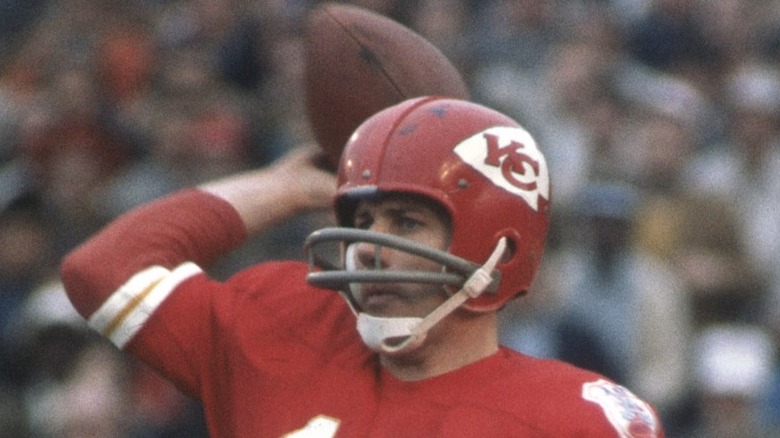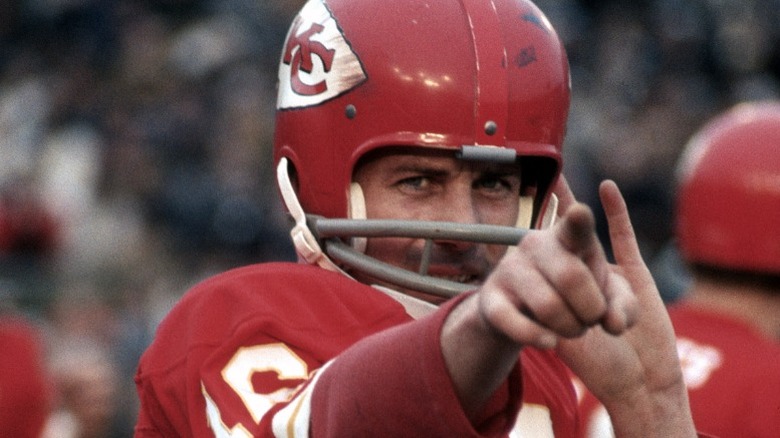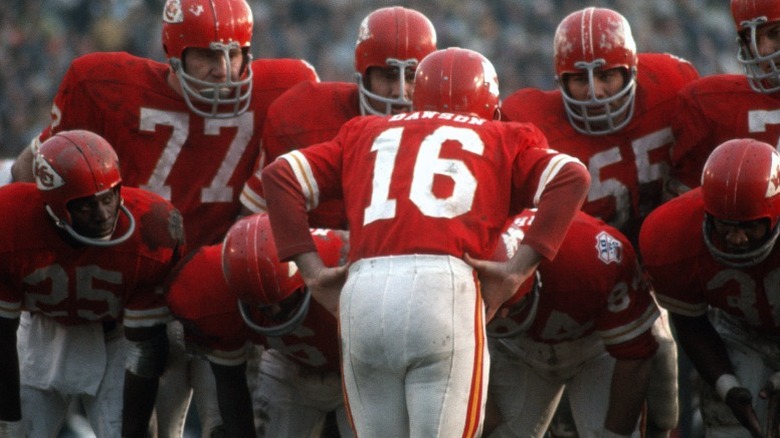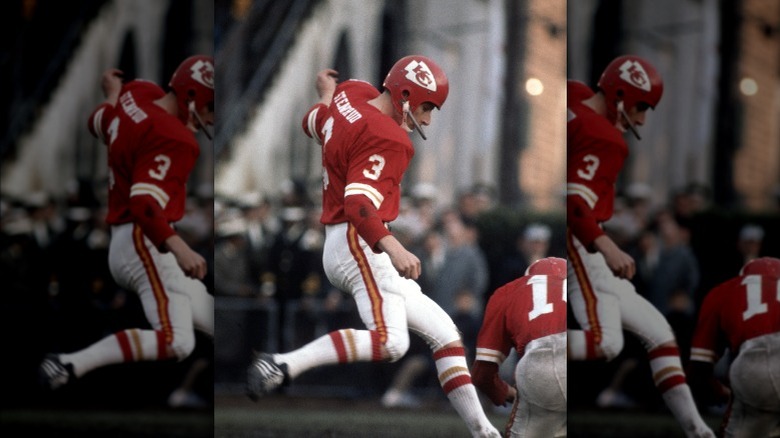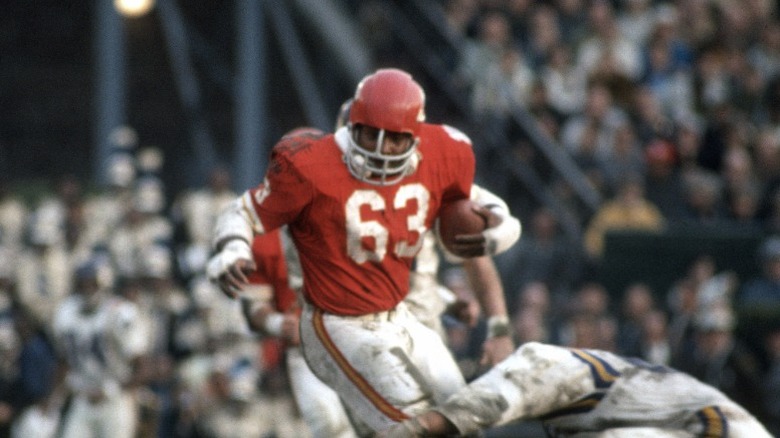What The Kansas City Chiefs' First Super Bowl Victory Was Really Like
As the 2022 NFL season kicked off, many fans looked to Kansas City as one that could be Super Bowl bound. And with good reason — stellar performances over the past several years made many fans wonder if this modern Chiefs team would be considered a sports dynasty. Five consecutive appearances in the AFC Championship game have made the sports world take notice of the club that will also be making its third Super Bowl appearance in four years. Under the leadership of two-time MVP quarterback Patrick Mahomes, the Kansas City team has put up impressive offensive numbers that have helped vault them back into the biggest game of the year this Sunday.
The 2020 Super Bowl victory marked the first time since 1970 that the Chiefs had appeared in the sports classic. A 50-year drought without a championship trophy had no doubt left the legions of Chiefs fans frustrated and disappointed over the years, sometimes only narrowly missing the opportunity to play in the most-watched game of the season (per Pro Football Reference). The span between Super Bowl victories included a long stretch without a playoff appearance at all. The Chiefs didn't see any postseason play after the 1971 season until 1986 when they lost to the New York Jets in that year's AFC Wild Card game. In those losing times, some fans recalled the first time their team hoisted the World Championship Game Trophy (changed in 1971 to be the Lombardi Trophy, per Pro Football Network) and talked of how an underdog team plowed their way through the playoffs and beat the Minnesota Vikings to end the 1969 season.
It was an uphill battle for the Chiefs at the start of the 1969 season
After winning all six pre-season games, the Kansas City Chiefs were poised to start their 1969 season with needed momentum. NFL scheduling had given the team a pretty tough row to hoe out of the gate, as the Chiefs were the visiting team for the first four games of the year. To overcome the odds, the team looked to powerhouse quarterback Len Dawson to lead the charge. But as the season unfolded, the defensive line also etched its way into the sports history books. Arrowhead Pride reports that the starting members of the Chiefs' defense that season included nine Pro Bowl players and five future inductees into the NFL Hall of Fame. The defensive warhorse proved to be critical during the season, especially after disaster struck the team during their second regular season game. While playing the Boston Patriots, Dawson sustained an injured knee that took him off the gridiron for the next six weeks. That game proved to be a testament to the team's defensive tenacity, however — the Chiefs managed to shut the Patriots out 31-0, limiting their opponent to only 82 offensive yards.
In those days, only four teams made the playoffs — one from each league. With Dawson sidelined, it was going to be a near impossibility for the Chiefs to make the postseason, let alone vie as contenders. The news only got worse when their backup quarterback Jacky Lee broke an ankle and was replaced by second-year player Mike Livingston. But the team persevered.
The defense carries the Chiefs
Without Lee Dawson, some Chiefs fans might not have had high hopes for the team. Kansas City suffered its first loss in the third game of the season in a narrow 24-19 game to the Cincinnati Bengals (per The Football Database). But Mike Livingston was able to deliver behind the line of scrimmage. Also assisting was field goal kicker Jan Stenerud, who set an NFL record with 16 consecutive field goals made (per The Kansas City Star). And the defense in Dawson's absence gave new meaning to dominance. They shut out the Houston Oilers and limited the San Diego Chargers to a lowly field goal. The Raiders proved to be the thorn in the Chiefs' side, however, ending their winning streak with a narrow 27-24 victory at Arrowhead Stadium (per The Football Database). The Raiders would do it again in the final game of the regular season, beating the Chiefs in Oakland in a narrow 10-6 contest.
With that final loss to the Raiders, the Chiefs finished second in their division at 11-3 and made the postseason. It wouldn't be the last time the teams met that year, but first, the Chiefs needed to win the first playoff round against the New York Jets. In a defensive contest that only saw one touchdown (from Dawson), the Chiefs won 13-6 and were headed to play Oakland for the third time in hopes of making it to Super Bowl IV (per The Football Database). In a shocking game, the Chiefs took away Oakland's hopes of a first Super Bowl appearance with a 17-7 victory (via Pro Football Reference).
Underdogs
Kansas City took some pretty impressive defensive stats into Super Bowl IV. Arrowhead Pride reports that the 1969 team allowed the fewest number of points against them at 177. The Chiefs' defense was ranked number one in the league in first downs allowed at 181 and total yards allowed per game at 224.9. Overall, their defense led the AFL in 10 additional categories. Despite those impressive numbers, Kansas City was considered an underdog against the Minnesota Vikings, whose numbers were even more dominant.
The Vikings were the definition of a perfectly balanced team on the field. Vikings Territory tells us that the 1969 club topped the NFL in points scored, fueled by the rocket arm of quarterback Joe Kapp. In a game that had field goals and rushing touchdowns dominate the offense, Kapp threw for 19 scores that year, an impressive number during that era. The Vikings ended the season as defensive leaders as well, allowing the fewest points in the NFL. But perhaps the most impressive statistic from that season was the margin of victory the 12-2 Vikings had over opponents — the average Vikings victory that season was an astounding 17.6 points. The Chiefs' defense had its work cut out for them going into the final game.
The Vikings were heavily favored to win when the two teams faced off on January 11, 1970. A crowd of more than 80,000 fans crammed into Tulane Stadium in New Orleans (per Pro Football Reference). The Vikings received the first kickoff, a 60-yard punt by Jan Stenerud that resulted in a touchback. The Chiefs' defense held, and the Vikings decided to punt.
An epic defensive game gets underway
The Chiefs scored on their first possession, a 48-yard field goal by Jan Stenerud. After kicking another touchback to the Vikings, the Chiefs were able to neutralize their offensive charge (per Pro Football Reference). For the second straight possession, the Vikings were forced to punt from their own territory. This time, a costly penalty for pass interference put the Chiefs into Viking territory. It paved the way for a second Stenerud field goal, giving the underdog Chiefs a 6-0 lead.'
The Chiefs' defense continued to hold. After forcing the Vikings to fumble on their next possession, the Chiefs' offense had a quick chance to score deep in their opponent's territory. But the Viking defense showed up, intercepting a pass from Chiefs quarterback Len Dawson. Still, the defensive show by the Vikings was short-lived. Before halftime, the Chiefs scored another 10 unanswered points, including another Stenerud field goal and a rushing touchdown from Mike Garrett. When the teams left the field at the halfway mark, it was 16-0 Chiefs.
The third quarter was nearly finished by the time either team put any points on the board in the second half. This time, it was the Vikings who drew first blood. With a little more than five minutes left to play, Dave Osborn rushed across the goal line to make it 16-7 Chiefs. It was the only time that day that any Viking made it across that line.
The defense holds
On their next possession, the Chiefs answered back. This time, it was a 46-yard rocket pass from Len Dawson to Otis Taylor for a touchdown with less than two minutes left in the third quarter. This play put the Chiefs on top 23-7, and they stayed there as the two teams started the fourth quarter (via Pro Football Reference).
The final quarter of Super Bowl IV was a true defensive showdown. And even though the Vikings' defense finally played to their full potential and kept the Chiefs from scoring a single point in the last 15 minutes of gameplay, it was the efforts by the Chiefs' defense that football history remembers. On two straight possessions by the Vikings, the Chiefs' defense intercepted passes thrown by Joe Kapp. During the Vikings' third possession of the quarter, Kapp was sacked for a 13-yard loss and a forced fumble by the Kansas City defense. The Vikings maintained possession, however, when Jim Vellone pounced on the ball. Kapp left the game after the play and was replaced by quarterback Gary Cuozzo. After throwing one completion in two attempts, Cuozzo threw the ball right into the hands of Chiefs defender Emmitt Thomas with only 4:29 left to play in the game.
The Chiefs kept Dawson on the field for the final possession of the Super Bowl. Though they managed to get the football into Viking territory, they wound up running down the clock on third down with 2 yards to get on the Minnesota 37-yard line. As the clock expired, the 1969 Kansas City Chiefs marched off the field with their first NFL championship.

